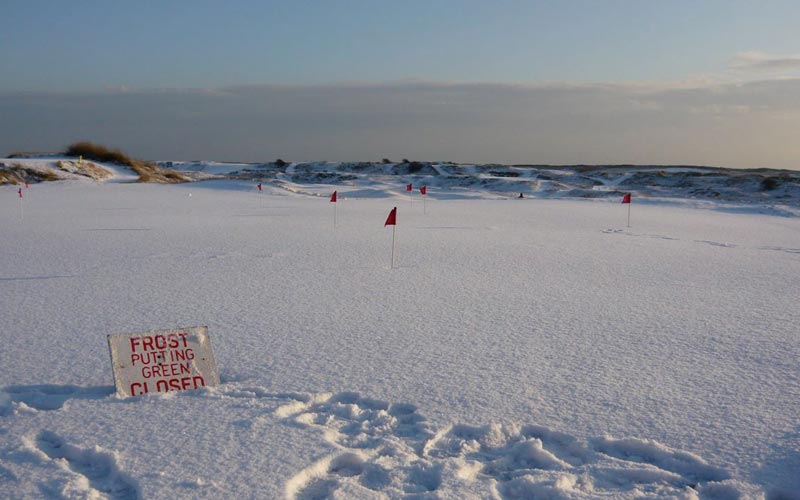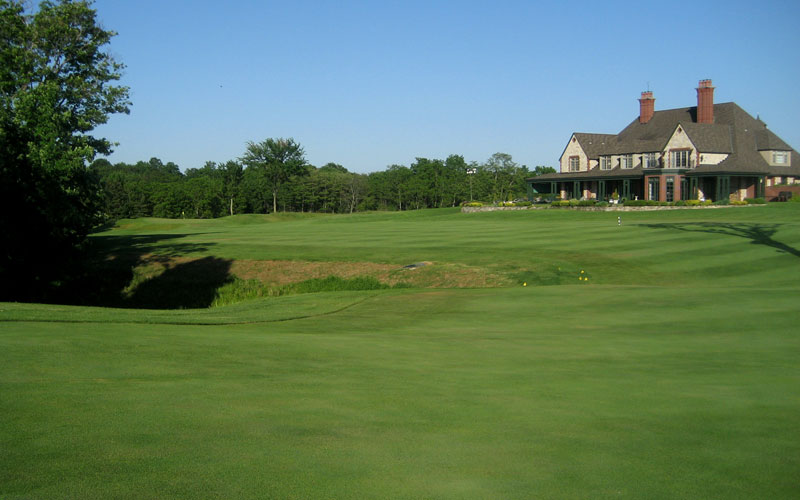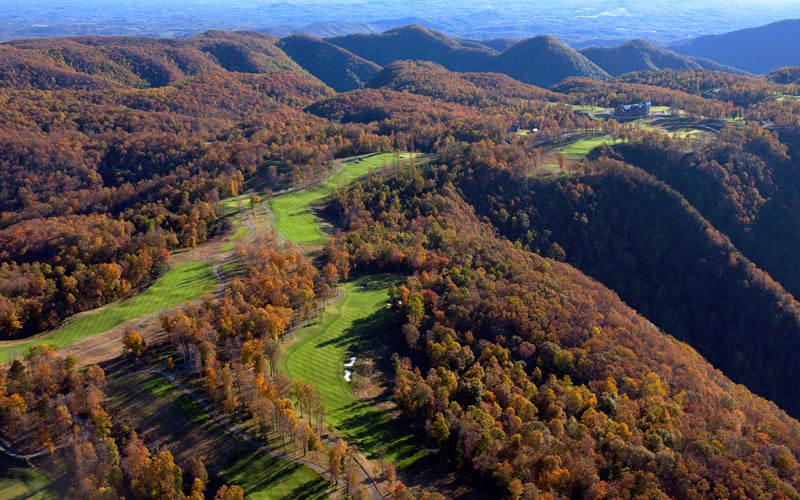Feature Interview with Donald Steel
January, 2010

A rarity occurred in 2010 and that was that the playing of President's Putter was delayed a few weeks due to weather.
1. Your record in the President’s Putter is sterling – what playing strengths in your game allowed you to excel in this winter match?
I once described The President’s Putter at Rye as “serious funâ€, the title the Oxford and Cambridge Golfing Society (the world’s oldest nomadic Society) gave their History in 1997. The tournament is probably best known for defying the elements but that is overdone. It is a genuine match play competition in which no effort is spared.
My successes were based on a love of Rye, a good blood circulation and the ability to improvise. Otherwise, the playing attributes are no different to those in any other form of competitive golf. Good driving and a nifty short game were certainly no hindrance.
2. As a test of golf, do you consider Rye at the same level as some of the Open courses?
You cannot compare Rye with the Open championship links on account of its length. It has five par 3s and only one par 5 but, in terms of the pleasure it gives, it is way up there. Difficulty is a relatively small element in measuring greatness in a course and enjoyment. Rye has many shots that would test the finest. For a day’s golf, there is nothing to beat it.
The make-up of a layout is no benchmark either. Courses should not be standardised. The modern belief in a 72 par with two 3 and two 5s in each half is absurd. There is a lot to be said for five par 3s. Golfers enjoy good short holes, they don’t take so long to play and today’s best players probably drop more shots on them than on 4s and 5s. It is said that the hardest part of playing Rye is the second shots on the short holes.
3. How much interaction did you have with Bernard Darwin? What sort of player was he? Did his writing in any way influence yours?
I met Bernard Darwin once. That was for the Oxford v Cambridge match at Rye in 1958, a match he never missed. However, he was a supreme partisan and my Cambridge allegiance was what attracted him to beckon me over to the corner of the bar where he was seated. For the two days of the match, his Oxford friends were given the cold shoulder.
He was very immobile in 1958, the victim of arthritis, a strong similarity to the pitifully frail condition ten years later at Augusta when I was fortunate to meet Bob Jones for the only time but their minds were razor sharp. They were precious occasions.
Darwin was a fine player- the reason he wrote so understandingly. He was a last minute stand-in for the singles in the first Walker Cup match on Long Island in 1922. He won his match against William Fownes, the son of the founder of Oakmont. Darwin was also a semi-finalist in the British Amateur and won a host of other tournaments, matches and medals.
Nobody reading Darwin could help being aroused by his descriptive powers. Certainly, nobody could have copied his style but I was conscious of the standards he set and envied such a fertile mind that brought such variety to his books and articles. I love quoting Darwin for the sheer joy of doing so. In a recent writing exercise on 150 years of The Open Championship, I realised that, without his epic contribution, particularly in the 1920s and 1930s, nobody would have known what happened in the Open.
4. In regards to the climate for both golf writing and course design, how is each different today than from when you started?
Golf writing has changed totally. There is a ridiculous obsession today with professional tournament golf and magazine instructional articles. Writers are no longer allowed to write about the general golfing scene. Competition with television and the internet hasn’t helped. Unfortunately, there has been no readers’ revolt.
Golf course architecture, as it has always done, has adapted itself to the times. In recent years, this has been to counter the advances in equipment and the height and distances the modern ball can be hit. Courses are now built in every landscape imaginable but the style of courses is largely decided by climate and a dependence on irrigation. However, the traditional game of bounce and run is making a comeback in many countries- if, indeed, it has ever gone away.
5. Have you ever considered doing an inland companion to the superb Classic Golf Links of England, Scotland, Wales, and Ireland first published in 1992?
I should love to do a follow up to The Classic Golf Links. All I lack is a publisher. My suggestion would be a book on heath land courses. My liking for writing about courses is a legacy of Darwin.
6. How did you get into design? Where you a pioneer or did you follow a path laid down by others?
I got into design at the invitation of Ken Cotton. When I started writing for the Sunday Telegraph in 1961, aged 23, Ken asked if, as a journalistic exercise, I would like to see his two new courses at St Pierre and Ross-on-Wye. It was fascinating as hardly any new courses had been built in the period between World War II and 1961. We kept in touch and a year or two later, as new course work started to expand, he asked if I would care to learn the ropes and help out. I needed no urging. I joined forces with Ken, Frank Pennink and Charles Lawrie, wonderful men and all fine players.
7. Who are your favorite golf writers today?
Of newspaper writers, John Hopkins and Derek Lawrenson but I worry about the future of golf writing. Newspapers think only of the professional world and are too keen to ask what I call “guest artists†to contribute on big occasions. That is all to the detriment of professional journalism. As I said earlier, there is a big threat from television and the internet. You writers don’t have the same opportunity that we had.
8. In your design career, what has been the evolution of the revetted bunker (especially at places like Hoylake and other Open venues)?
Revetment is a technique adopted to prevent the face of a bunker from collapsing. It is more common on sandy links courses where bunkers tend to be small but can be excavated fairly deep- with fairly straight faces. Hoylake, where the water table is higher, has bunkers where the faces are more above ground but the building technique, layers of turf (sod), is the same.
9. Is stacked sod at odds with the naturalness of links courses?
All bunkers are unnatural- the one obviously introduced element on any golf course. Revetted bunkers are perhaps more natural than any other. Originally, the idea of a bunker was created by sheep burrowing into slopes to seek shelter.
10. Tom Mackenzie was your design associate at projects like Skibo and Redtail. Since you parted ways, has your design style changed much?
I don’t believe my design thoughts have changed. However, design is not akin to signing your name. It should reflect the terrain. All courses are different and should be made so. Design is not a matter of applying a formula.
11. What pleases you the most in how Redtail turned out?
Redtail (1987) was my first sortie into Canada and the United States. I owe it a huge debt. I love the peace and solitude that it evokes. Golf is an escape from worldly, domestic and business worries. Nowhere is that truer than Redtail. A lovely setting gives any golf course a head start where reputation is concerned. Redtail blends well with the landscape but it mounts a pleasing challenge that golfers enjoy. Architects shouldn’t judge their own work but are pleased when their courses prove popular. However strenuous the challenge, golf courses should be playable and possible.
12. Talk about the origins of the fabulous drivable seventeenth at Skibo.
Part of Skibo’s evolution was a desire to finish the round alongside the Loch Evelix and within sight of the Castle. The 16th, 17th and 18th occupied the land beyond the clubhouse and were tailor made for a rousing climax. I have always loved good short par 4s and the 17th fitted the bill perfectly although modern equipment has made it play shorter than it did in 1987 in spite of lengthening the hole. In addition to out of bounds on the left, and the angling of the green, bunkers offer the tantalising decision between discretion and daring. You can also add the distraction of the surroundings.

The tee shot at the 17th with bunkers and options galore. A tee ball long down the left toward the left edge of the green can be feed onto the green by the slope of the land.
13. Both Redtail and Skibo end with risk reward par five holes. All things considered, is that your favorite sort of finishing hole?
That was just way things turned out. In their individual context, a short par 5 represented the correct finale. I suppose that is true of most finishing holes but, if the 18th posed a scholarship question for golfers, I don’t think you can improve on a really stern par 4. At Birkdale in 1983, Tom Watson won his fifth Open, with a four to win, by hitting a drive and 2-iron (473 yards) to the heart of the green. Nobody begrudges victory to a man who can do that.

From the landing area of the three shot eighteenth, the golfer must decide which avenue of attack to pursue. The clubhouse's relation to the home fairway is the mirror image to the clubhouse along the famed eighteenth at National Golf Links of America.
14. How hard did you push to get near the water at Cherokee Plantation? Or before you accepted the project, was it a foregone conclusion that you wouldn’t be allowed near it?
We had little say in the matter. Golf holes near the water would never have been allowed.
15. What are your three favorite courses in the United Kingdom that are a bit off the beaten path and of which not many overseas visitors may be familiar?
Saunton, Seacroft and Southerness.
16. Talk about the opportunity and challenge at Primland.
Not many architects have the pick of 12,000 acres for an 18-hole golf course. At first, that was a daunting prospect but the realisation that the lower land at Primland revealed nothing remarkable finally focused attention on the top of the mountain. Doubts about an inhospitable environment for growing grass were soon dispelled by information that it had once been farmland and the immediate awareness that a golf course in such a setting would be spectacularly unique. Confirmation that the right decision was made followed in the location of The Lodge. Nowhere else would there have been views to die for.
The only downside was that there was little ready made about the golf course. However, this was overcome with the correct topographical information, an adjustable concept, patience, good fortune and an army of skilled consultants and operators. One of the major problems was the wooded state of the site and some deep valleys and ravines but, gradually, the layout took shape and, once plotted, remained fixed.

'The above Joann Dost photograph captures how Steel routed the back nine along the spine of the mountain.
17. The eighteenth green at Primland is a 12,000 square foot stunner. Walk us through the design thought process on concluding the course with the largest green on the course.
Primland is a vast canvas. It seemed appropriate to have large greens to help fill the vastness. The 18th is one of the biggest but large greens enable an architect to build in interest, contour and pleasant slopes. One consideration was that Primland is primarily a resort course. On a highly played private members course, something more conventional might be preferred. Primland’s greens receive plenty of comment but little of it critical. The 18th is a tough par 4. The idea was a large target and plenty of opportunity to take three putts.

'This Joann Dost aerial looks down the long par four eighteenth which is capped off by a rolling 12,000 square foot green featuring innumerable interesting hole locations. As seen to the left, Primland's first rate and highly distinctive lodge comes complete with its own observatory.
18. Talk about your work on the Carlson Farm Course at Greensboro Country Club.
The big difference between The Carlson Farm course of Greensboro CC and the normal major refurbishment is that Carlson Farm was blessed with spare land. This increased the scope for change and expansion. As a result, three brand new holes were introduced and six significantly redesigned with every green, tee and bunker rebuilt. In addition, extensive practice facilities were introduced and there was a change of fairway grass to zoysia. It was a most exciting exercise that led to the members feeling they had a completely new course.
The End








